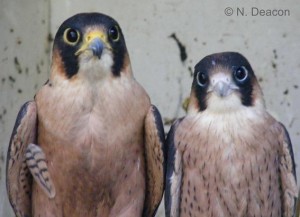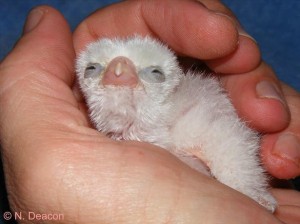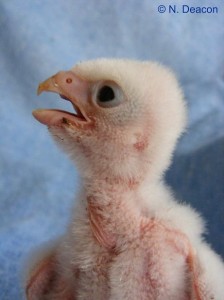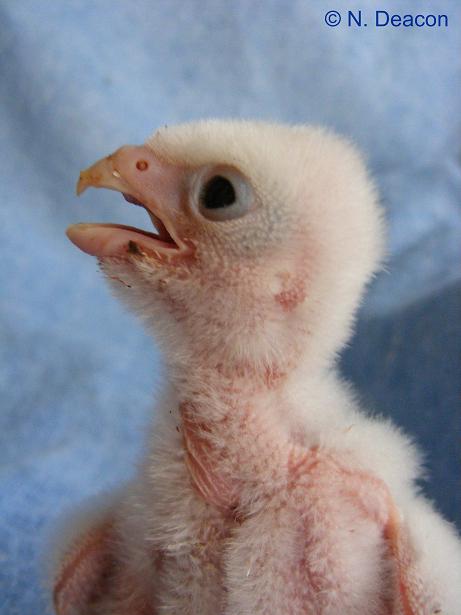What to do with captive bred Taita Falcons?

Unexpected breeding success from a pair of captive Taita Falcons (Falco fasciinucha) leads me to contemplate the fate of this offspring. The aim of the Zimbabwe Falconers’ Club (Z.F.C.) Taita Falcon breeding project was to establish a captive population from which to propagate the species and ultimately release Taita Falcons to the wild (Hartley, 2002).
Although there has been some success, the program has bred 15 offspring from 10 pairs; the Taita Falcon has proven to be a poor candidate for captive propagation. While Taitas are delicate and difficult to breed, the main limitation is their low fecundity. This species seldom re-lays eggs in the event of failure, a shortcoming that restricts productivity as breeding is limited to one attempt per year.

Taitas only start to lay eggs at 4-5 years and reach senescence at about 15 years (Hartley, 2002), so effectively have ten opportunities to reproduce. The average clutch size is 2.9 eggs (Hartley, 2000).
This leaves no scope to manipulate reproductive success in the event of a sterile clutch or boost productivity by double clutching. Sterile clutches are common, even from established breeding pairs that are fertile one year but fail the next despite being kept in the same conditions and fed the same diet.
The productivity of Z.F.C. captive Taitas was 0.33 chicks/pair/year, less than half of that of six pairs of wild taitas measured at 0.88 chicks/pair/year in the early 1990’s (Hartley et. al, 1993). However, in Zimbabwe breeding territories traditionally occupied by

Taitas have declined by over 60% in the last decade (Z.F.C., unpublished data). While this decline is unexplained, it seems that release to the wild is perhaps not the best use of a captive bred Taita Falcon. Still it saddens me to condemn this bird to live out its days in an aviary.
References
HARTLEY, R.R., BODINGTON, G., DUNKLEY, A.S. & GROENEWALD, A. 1993. Notes on the breeding biology, hunting behaviour, and ecology of the Taita Falcon in Zimbabwe. J. Raptor Res., 27:133-142.
HARTLEY, R.R. 2000. Ecology of Taita, Peregrine and Lanner Falcons in Zimbabwe. Pp. 87-105, in: Raptors at risk (eds). CHANCELLOR, R.D. & MEYBURG, B-U. World Working Group on Birds of Prey and Owls. Hancock House.
HARTLEY, R.R. 2002. Breeding the Taita Falcon in captivity. Honeyguide, 48: 227-233.
Neil Deacon
Zimbabwe Falconers’ Club, P.O. Box 2986, Harare, Zimbabwe
neil@dab.co.zw





We only have one pair of Taita Falcons so I can only comment on this pair. We have also only had the birds for 3 seasons. Our pair have over the last two seasons double clutched with only one egg being infertile on the second clutch. This last season we allowed the female for the first time to incubate and hatch chicks. She hatched one egg and the other had entered the air cell and died. The 3rd egg was infertile. We have bred 6 chicks in three years.I agree that they may be a challinging species to breed, and may be we have an exceptional pair, but at this stage I beleive this species can be propogated with reasonable success
I have heard of your exceptional success with this pair. If these results could be extended to a number of pairs then I would agree that there is some merit in continuing with captive propagation of this species. However, I still think that removal of taitas from the wild for this purpose cannot be justified on results achieved so far. Even though your pair is young and inexperienced, double clutching has not yet significantly increased productivity. Two chicks a year from 6 eggs a season is no improvement on 2 chicks a year from single clutch (av. 3 eggs). Although potentially productivity could be doubled. This is not a critism but a respectful observation. Another restriction to captive propagation is the limited gene pool of successful pairings. I understand that your pair is of siblings from the same clutch. From our records, the limited success we have had is only from two original bloodlines or pairings. This F2 tiercel is from a pairing of offspring from the original two pairs. Another pair also of the same bloodline also bred. Collectively the captive population is being rapidly inbred. So if not all pairings work and productivity is limited, how many taitas would have to be removed from the wild to etablish a viable and genetically representative captive propagation programme? At this stage, perhaps way too many. May be the planned exchange of captive bred stock will provide results that will change this opinion.
Dear Mr.
I have read your article on the Taita falcons, and I would ask your support on the following information.
I’m about to acquire a 50% barbary falcon x 50% Taita, is a volunteer donor, has only 2 years, but I wonder how high risk are on the side of Taita be infertile.
I live in Mexico and I used to inseminate the falcon or a female prairie falcon or a female peregrine falcon anatum.
Can you help me with my doubts, it is a high investment that I do.
I appreciate your support tremendously.
With kind regards and Merry Christmas
Att